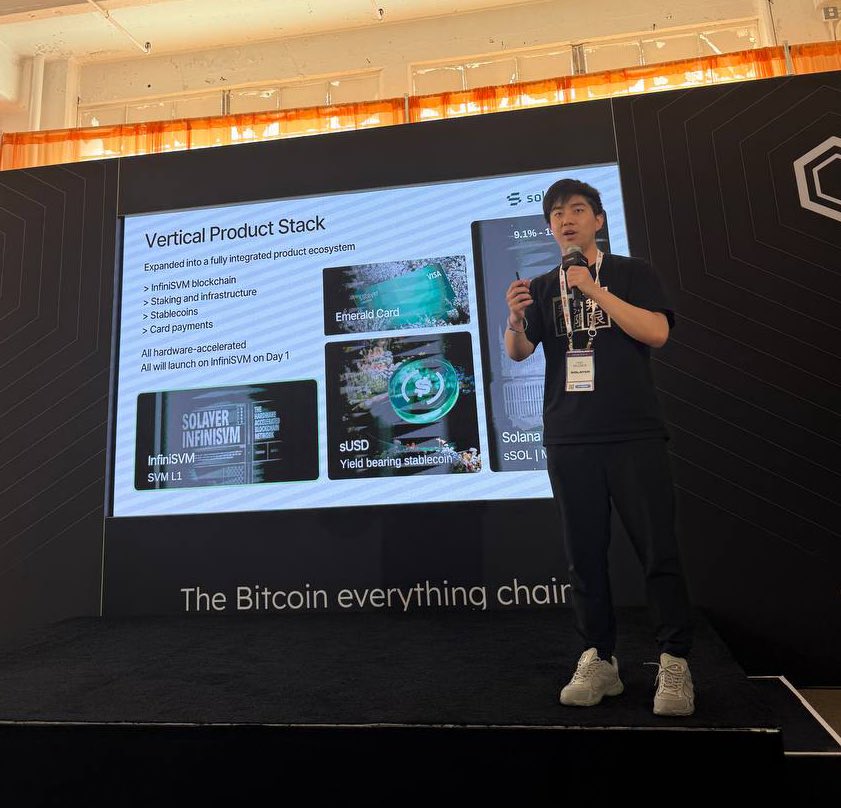Looking back at what @solayer_labs has done in the past six months, it seems quite scattered at first glance, from hardware-accelerated chains to liquidity staking to real yield stablecoins, and then to on-chain debit cards, it appears to be aiming for a "unified financial infrastructure." The initial purity of being a high-performance layer 1 is long gone; how should we view this?
In simple terms, Solayer's approach is very clear: instead of making single-point breakthroughs, it is laying out a full-stack product line, directly aiming for the "financial operating system" of the Solana ecosystem, to achieve a closed loop from underlying technology to end-user consumption.
sSOL liquidity staking + sUSD yield stablecoin + InfiniSVM high-performance TPS chain + Emerald debit card, these four product lines seem unrelated, but they cover the complete chain from infrastructure layout, asset appreciation to payment consumption.
1) Interestingly, the design of $sUSD, based on the real yield of short-term U.S. Treasury bonds, directly impacts the "lying flat" stablecoins like USDC with a 4% T-bill yield.
I have previously written about the vast market space for yield stablecoins. $sUSD reached a TVL of $32M in just three months, which indirectly supports this judgment. This idea of packaging traditional fixed-income financial products as on-chain native assets can bring real and sustainable sources of income to the Crypto world, aligning well with the current market needs during the TradiFi + DeFi integration phase.
2) The claim of 1 million+ TPS performance breakthrough sounds a bit intimidating at first, but not being fixated on the numbers, the hardware acceleration + SVM-compatible InfiniSVM expansion solution gives a strong impression of serving the future "super chain."
I have also emphasized this point in previous writings; although the Solana mainnet's approximately 4,000 TPS is sufficient for most application scenarios, when serving future high-frequency DeFi interactions, professional on-chain gaming, high-frequency arbitrage MEV, and instant payments—scenarios that are extremely sensitive to latency—InfiniSVM's extreme pursuit of performance will come into play, similar to the approach of Sonic SVM focusing on gaming scenarios.
However, whether the basic infrastructure is overperforming or underperforming needs further market validation; there must be enough developers and various high-frequency application scenarios to land.
3) The design of $sSOL is also quite good, with the clever aspect being the construction of a dual yield mechanism of staking + restaking. After users stake SOL to obtain $sSOL, these $sSOL will also be automatically restaked into the InfiniSVM network to provide security verification services, forming a combined effect of SOL native yield + Solayer ecosystem incentives.
In fact, this design of combined yield effects is very attractive, already having only 300,000 users and over $500 million in TVL, providing good DeFi composability for $sSOL.
4) Mentioning "on-chain debit cards" is not a particularly new concept, but the differentiation of the Emerald card lies in its deep integration with Solayer's own yield-generating assets, meaning users can maintain their original yield experience during the consumption process.
Imagine, users put funds in $sUSD to earn interest, and when they need to spend, they can swipe their card directly, experiencing a sense of "earning while spending." The entire process is traceable on-chain, and the yield continues to accumulate. Moreover, the Emerald card supports coverage in over 100 countries, ATM withdrawals, and compatibility with Apple/Google Pay, among other basic configurations, which will lead to a rapid penetration speed. The increasing number of bloggers sharing their debit card experiences is evidence of this.
In summary, Solayer has adopted a four-in-one full-stack strategic product line development, attempting to create a closed-loop financial consumption ecosystem. Compared to a purely high-performance public chain narrative, this financial operating system's positioning indeed adds a lot of imaginative space.
However, no matter what, InfiniSVM is the core mainline of Solayer's development; only when the ecosystem of this hardware-accelerated chain is truly activated can the other laid-out product lines gain corresponding synergistic benefits.
Show original9.96K
22
The content on this page is provided by third parties. Unless otherwise stated, OKX is not the author of the cited article(s) and does not claim any copyright in the materials. The content is provided for informational purposes only and does not represent the views of OKX. It is not intended to be an endorsement of any kind and should not be considered investment advice or a solicitation to buy or sell digital assets. To the extent generative AI is utilized to provide summaries or other information, such AI generated content may be inaccurate or inconsistent. Please read the linked article for more details and information. OKX is not responsible for content hosted on third party sites. Digital asset holdings, including stablecoins and NFTs, involve a high degree of risk and can fluctuate greatly. You should carefully consider whether trading or holding digital assets is suitable for you in light of your financial condition.



